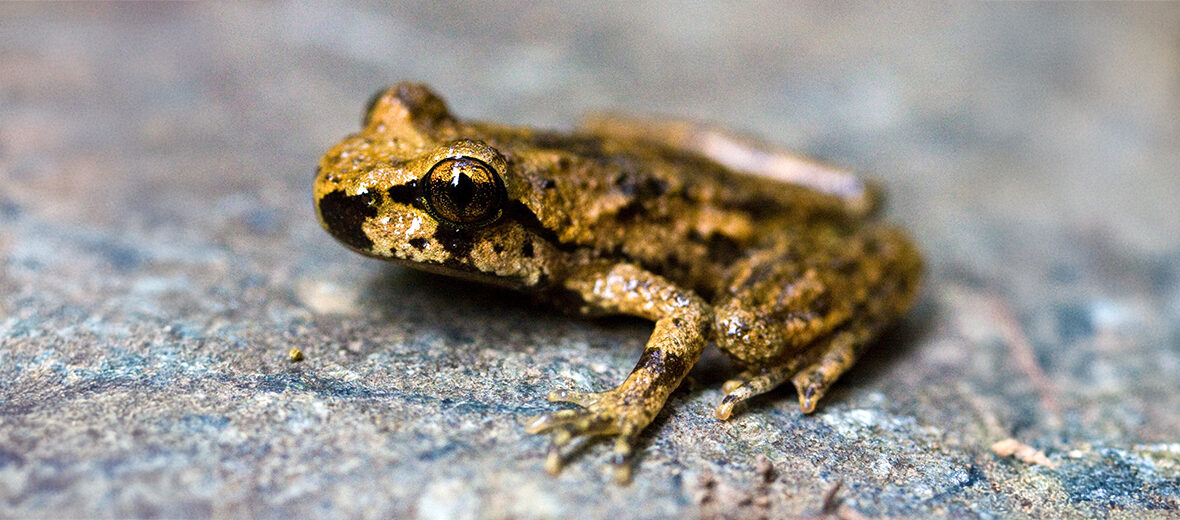
Among the most primitive known families of frogs, the tailed frog comprises 2 known species in the genus Ascaphus which is the only taxon in the family Ascaphidae. These frogs face the threats of habitat destruction at the hands of the logging industry; habitat division at the hands of roads and railroads, that can also result in vehicle strike (being hit by vehicles); pollution, in the form of water and land pollutants; and disease, which takes the form of the deadly Chytrid fungus. However, both species of tailed frogs are listed as Least Concern by the IUCN.
First the Stats…
Scientific name: Ascaphus
Weight: Up to .15 ounce
Length: Up to 2 inches
Lifespan: Up to 20 years
Now on to the Facts!
1.) Tailed frogs are the only known North American species of frog to reproduce via internal fertilization.
2.) Their tail is actually an extension of the male’s cloaca (reproductive organ).
3.) These are among the most primitive known family of frogs.
4.) The scientific name Ascaphus translates to ‘without a spade’, from the privative prefix a- and the Ancient Greek skaphís (σκαφίς, ‘spade, shovel’), which refers to the metatarsal spade, which these frogs don’t possess.
5.) Up until 2001, the genus was believed to be monotypic (only having 1 species), the single species being the tailed frog (Ascaphus truei). However, in that same year, Nielson, Lohman, and Sullivan published evidence that suggested that the Rocky Mountain tailed frog (Ascaphus montanus) be moved from a subspecies to its own species.
But wait, there’s more on the tailed frog!
6.) The presence of the visible “tail” appendage makes this frog’s family distinct from all other frogs.
7.) As mentioned, the “tail” is found only in males, and is part of the cloaca. It is used to insert sperm into the female during mating. This anatomical feature improves their breeding success by minimizing the loss of sperm in the rough, fast-flowing streams inhabited by these frogs.
Did you know…?
These frogs are primitive to almost all other frogs in having 9 amphicoelous vertebrae and a caudalipuboischiotibialis tail-wagging muscle in adults, which is a type of vertebrae seen primarily in fish and early terrestrial tetrapod fossils.
8.) Tailed frogs do not have the ability to vocalize.
9.) Also unique to tailed frogs is their ability to secrete a series of antimicrobial peptides called ascaphins. These peptides share some similarities with antibacterial peptides found in African scorpions, and fight off bacteria like E. coli and S. aureus.
10.) When trying to mate, males will lunge at a passing female and attempt to move into amplexus (the mating hold where the male grips onto the female from behind).
But wait, there’s still more on the tailed frog!
11.) On some occasions there is male vs male competition for the female. In these situations, both males compete to enter the amplexus position, eventually with 1 establishing a better hold on the female and expelling the other male from the breeding process.
12.) Females produce 2 strings of up to 85 eggs that are laid in the water.
13.) Tadpoles can take up to 4 years to metamorphose into adult frogs!
14.) Various insects, spiders, and snails are readily consumed.
Now a Short Tailed Frog Video!
Be sure to share & comment below! Also, check out the Critter Science YouTube channel. Videos added regularly!

Want to suggest a critter for me to write about? Let me know here.
Some source material acquired from: Wikipedia & IUCN
Photo credit: Ken-ichi Ueda



